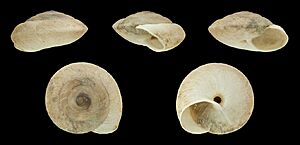Canariella hispidula facts for kids
Quick facts for kids Canariella hispidula |
|
|---|---|
 |
|
| A shell of Canariella hispidula | |
| Scientific classification | |
| Kingdom: | |
| Phylum: | |
| Class: | |
| (unranked): |
clade Heterobranchia
clade Euthyneura clade Panpulmonata clade Eupulmonata clade Stylommatophora informal group Sigmurethra |
| Superfamily: |
Helicoidea
|
| Family: |
Canariellidae
|
| Genus: |
Canariella
|
| Subgenus: |
Canariella
|
| Species: |
C. hispidula
|
| Binomial name | |
| Canariella hispidula (Lamarck, 1822)
|
|
| Synonyms | |
|
synonyms include:
|
|
Canariella hispidula is a small land snail that breathes air. It is a type of mollusk, like clams and octopuses. This snail belongs to the Canariellidae family. These are often called "hairy snails" and their relatives. Canariella hispidula is the main species that gives the Canariella group its name.
Contents
Where Does This Snail Live?
This snail is very special because it lives only in one place! It is found only on the island of Tenerife. Tenerife is one of the Canary Islands. This means Canariella hispidula is an "endemic" species. It naturally lives nowhere else in the world.
What Does Its Shell Look Like?
The shell of Canariella hispidula is quite unique. It is shaped a bit like a cone and is very strong. The top part of the shell is a light reddish-brown. It gets lighter in color towards the center, near the opening. This central part is called the umbilicus.
Shell Surface Details
The very first turns of the shell, called the nepionic whorls, have tiny bumps. The rest of the shell is covered with fine, curved lines. These lines are called riblets. The shell also has many small bumps, or granules. These granules are often arranged in a pattern like the dots on a dice.
Shell Shape and Size
The top part of the shell, called the spire, looks like a pyramid. The very tip, or apex, is sharp. The lines between the shell's turns are thin. The shell has five turns, or whorls. These turns are slightly flat on top and rounded underneath. The edge of the shell is slightly angled. The last turn is almost twice as wide as the one before it.
Shell Opening and Edges
The opening of the shell is called the aperture. It is shaped like a half-circle and is slanted. The edges of the opening are close together. They are connected by a thin layer on the inner wall of the shell. The outer edge of the opening is called the peristome. It is slightly curved and whitish. The bottom edge is rounded. The inner edge goes upwards and is a little wider. The umbilicus, the central opening, is wide and deep. You can see part of the second-to-last turn inside it.
Shell Measurements
The shell of Canariella hispidula is about 10.5 to 12 millimeters wide. It is about 6 millimeters tall.

